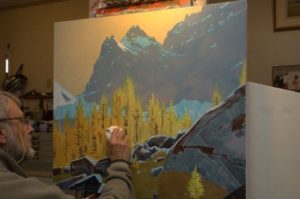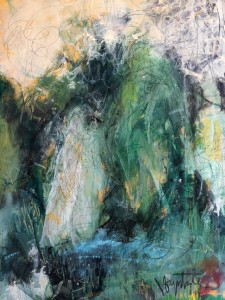Dear Artist,
Glazing is a technique where a transparent, usually darker, tone is washed over previously painted and dried passages. While primarily an acrylic technique, glazing can also be used in oils and watercolours. A glaze is applied with a brush, rag, spray or flood. When I come up to bat, it’s often a rag because on-the-spot judgment may suggest both wipe-on and wipe-off.

Analagous orange glaze being applied over acidic yellow. Then those larches, as they say, will be ‘ready to go back into.’
While dismissed by many painters as trifling with the main thrust of a work, glazing nevertheless increases the range and variety of creative expression. Further, because tones are later adjustable, glazing permits casual and energetic early passages.
Here are a few glazing keys:
The darker the tone you put the glaze on top of, the lesser the effect.
Conversely, the lighter the tone you put the glaze on top of, the greater the effect.
Glazing with opposites on the colour wheel creates sophisticated and engaging neutral tones.
Glazing with analogous colours (next to each other on the colour wheel) can enrich areas of your work.
Masking first and then glazing over high-key or bright areas can be used to create effects of light and shade.
Overall glazing can pull weak paintings together and give them a more unified feel and “mother colour.”

Foreground elements being toned down with a black glaze. Depending on the black you use, it can be either warm or cool.
Thin glazes of black effectively tones down garishness and sets up for “colour surprise” and “coming to light.”
Experimenting with thin glazes of Phthalo blue shows the potential before branching out to other glazing pigments.
In acrylic work, glazes automatically add a small amount of medium, thus improving the long-term health of surfaces.
With progressive layers of glazing, you can creep up on and find the tone you want. For those who seek correct and realistic balance between tones, a series of thin glazes will often do the trick. Overly dark passages can be subjected to glazes as well. Glazing with a lighter tone, in other words, with the addition of a somewhat transparent white, Naples yellow, yellow ochre or other pigment, can be a bit of a sticky wicket. You need to think of glazing in a sporting manner — it’s just another pitch and while it’s not everybody’s cup of tea, it’s still Cricket.
Glazing isn’t everything, but it helps.

Larches from Opabin Prospect, Yoho Park, B.C., 2008
acrylic on canvas
30 x 34 inches
by Robert Genn (1936 – 2014)
Best regards,
Robert
PS: “Trifles make perfection, and perfection is no trifle.” (Michelangelo)
Esoterica: I like to pre-mix a variety of glazes and keep them in squeeze bottles. These days, my thin glazes consist of about 5% pigment, 45% acrylic medium (gloss or matte) and fifty percent water. Glazing affects different surfaces in odd ways, especially where molding paste or impasto has been used. As usual, happenstance effects are gifts to be treasured.
This letter was originally published as “Glazing keys” on November 11, 2008.
Have you considered a Premium Artist Listing? With each letter, an artist is featured at the bottom of this page. The Premium Artist Listings are a means of connecting artist subscribers through their work. Proceeds from each listing contribute to the production of The Painter’s Keys.
“My app is the same juicy paint used by Vincent Van Gogh; my screen is the woven canvas of Titian. Painting by hand, I’ve come to figure, is a certain kind of love.” (Robert Genn)
Featured Artist
I grew up on a farm in Ohio, and that experience gave me a love of nature and the seasons and a deep belief in personal independence, as well as a love of experimentation. These have been the foundations of my work as a painter. I believe that learning in art or any subject is lifelong, and that the most important lessons we learn are through our personal interests and experimentation. After my husband’s death in 2018, I visited Israel the next year, and was inspired by the amazing landscape colors, and especially the old city of Jerusalem, with its crumbling walls, and its deep religious importance. I found my way out of grief by painting the Eight Gates of the old city.





7 Comments
Once again….Brilliant advice! Another Keys to keep!
The richness, depth and effectiveness of Mr Genn’s guidance and willingness to share his hard found knowledge continue to inspire and light the way.
Thank you for the info. I’m approaching glazing cautiously and sometimes forget it is a great tool for managing the work.
I always look forward to these letters.
Cheers!
Will there ever be a book of your dad’s paintings?
Hoping!
Hi Pat,
Love Letters to Art is currently available on Amazon, here: https://amzn.to/386yqM6
In friendship,
Sara
I’ve been working a thin oil paint glaze over acrylics for oomph. It works well.
Doesn’t that effectively end your acrylic adventure on that particular painting, as once you’ve used an oil based medium over acrylic, you can, more or less, never go back??